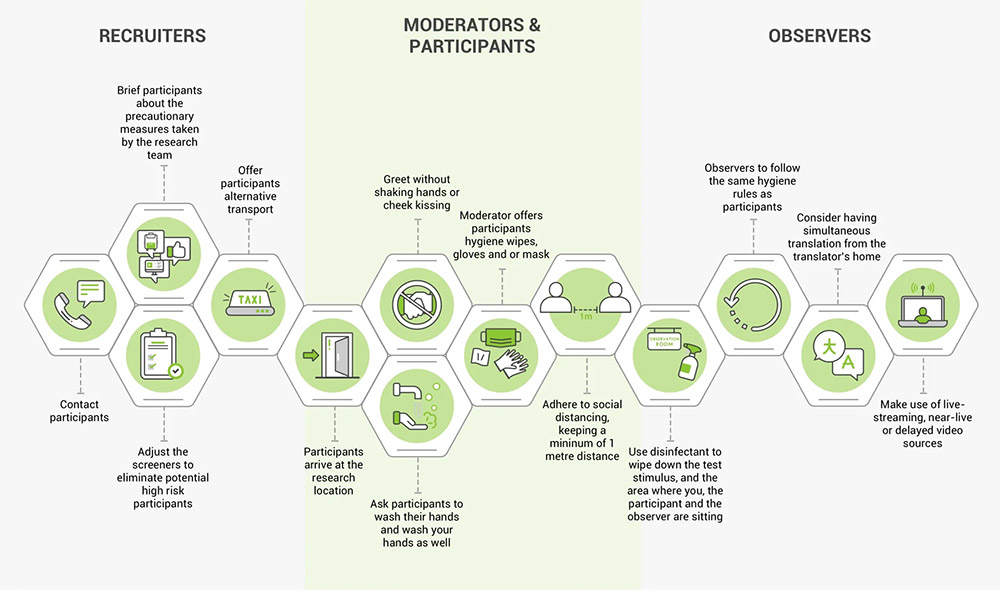
When companies introduced a travel ban in the past week and social distancing became a norm, alarm bells started across the research community. Personal interaction and communication is the heart of what we do. What happens when you can’t travel and meet users?Products still need to be developed, otherwise targeted benefits will be lost (and expensive product teams can’t be idle). So either we stop research and wait for it to clear, or press ahead without user engagement. This risks sub-optimal products long after COVID-19 recedes.So what do we do?
The UXalliance is a global research organisation that’s collaborative to the core, and we’ve been regularly sharing experiences and learning from each other as COVID-19 has spread globally.
We have put together some tips to help you with your research:
Products still need to be developed, otherwise targeted benefits are lost (and expensive product teams can’t be idle). The options are:
The good news is that UX research is now global and there are strong research providers who can help clients who can’t travel. Many are used to working remotely for international clients. In fact, it’s the core of what we do at the UXalliance. The research providers can become the in-house team’s eye’s, ears and hands on the ground, localising research, streaming sessions and sharing video/audio globally. The impact of COVID-19 varies considerably and they know what is achievable locally (they also understand any necessary workarounds, for example where bandwidth isn’t great).
COVID-19 is about good hygiene and we’ve seen extra safety and hygiene measures protect and reassure. These vary in degree depending on the local COVID-19 status. The World Health Organisation have published detailed guidelines, click here. In terms of recruitment, we suggest you adjust the screeners to eliminate potential participants that may have contracted the virus and high risk groups. Also, have extra time buffers in case of no-shows and self quarantine occurring.
For the safety of the participant, make extra efforts to sanitise any surfaces touched between sessions, follow WHO good hygiene practice, and maintain a social distance between moderator and participant during the session.

Research is happening in even the most infected countries. The choice of workaround depends on the objective of the research.Immersive research feels the most vulnerable to disruption. How can you really immerse yourself in a customer’s experience halfway across the world when you are grounded? Diary studies combined with a “co-immersion” workshops with a local UX research team are a great workaround. Here, the local team can perform the context immersion, record it and walk you through the deeper insights in a debrief session. This may actually work better as you the “foreigner’ may not be there to bias the audience and you get to understand the localised social behaviour firsthand. Combine this with diaries and user-generated video it can be a good way of bringing you closer to the users lives.
Focus groups are also vulnerable (it’s not really the time for bringing together groups of strangers in confined spaces). We’ve seen technology help through the use of remote video hangouts and other forums instead. Collaborative tools can also get participants working in a common digital space, for example Whimsical, Miro and Mural. On Friday 13 March 2020, the Italian team at Assist Digital in Milan, conducted the first remote focus group and made use of some of the tools to enable interaction.

We looked at every type of research and found some good workarounds to get depth of results with a few tweaks here and there. We’ve been trialling these, iterating and improving. The optimal mix will depend on the research needs, if you do need any help with a workaround, feel free to get in touch.
If you’re not travelling for international research, you’ll need to work effectively across time zones. It’s a natural disruption the UXalliance has worked with for some time.Finding the cross-over times, is key to briefing and debriefing teams and running pivot sessions. Beyond this, you can use comprehensive checklists for activities which can happen asynchronously. Working with research partners familiar with global testing ensures this process runs smoothly.
Video streaming and screen sharing are possible across platforms and are very effective tools. This is straightforward in many parts of the world, but limited bandwidth can make this tricky elsewhere.
We typically find three scenarios for remote viewing:
No technology restrictions for streaming — The best-case scenario is where you observe the session real-time and collaborate with the local team using online chat and boards. This is possible in many countries, especially in the major cities. It’s a great contingency in most instances.
Unstable bandwidth — Near-live viewing involves a lag of up to 5 to 10 minutes to the stream. The lag creates a buffer, which ensures smooth viewing if there are large fluctuations in bandwidth in a country.
Local researchers will know about this and can guide remote observers on the possibilities to collaborate with the researchers. The sessions are typically sequenced to ensure feedback is provided and observers remain engaged.
Insufficient bandwidth — Delayed video upload can be used when the bandwidth is too limited. In this situation, a session video is uploaded either just after a session or within a couple of hours. With sufficient briefing, piloting and periodic check-ins (e.g. half-daily), it is still possible to engage remote observers.
One thing is clear: we are in unprecedented times! And COVID-19 gives us some unique challenges when doing global research. However, as Rahm Emanuel already said: “Never let a serious crisis go to waste.“ So let’s adapt to this new situation and make the most of it. The good news is that we’ve never had better technology or global know-how to deal with these challenges!